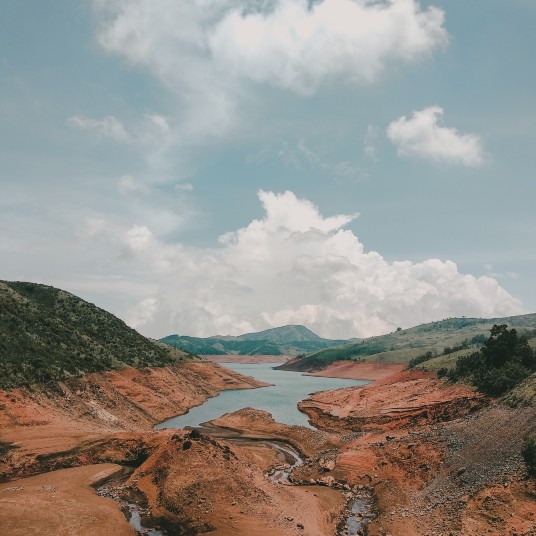When water shortage impacts on the desert: story of the Middle East
Water scarcity is one of the greatest challenges facing the Middle East – and climate change is making the situation worse. Discover which sustainable solutions could mitigate the problem.
Where before there was a great mass of water, today there is only dry soil and dust. Lake Urmia in north-east Iran was once the biggest lake in the Middle East and sixth largest saltwater lake on Earth. Now it has almost dried up completely, leaving behind just a salt plain.
This is not an anomaly in the region. The top spots in the ranking of countries with the highest water scarcity in the world are occupied by Middle East nations – places where the annual use of water is much higher than the available supply.
What will I learn from this article?
Water shortages in the Middle East
 Water is a frontline problem for the world in general and especially the Middle East. The Aqueduct Water Risk Atlas published by the World Resources Institute highlights that 8 out of 10 countries with high water stress are located in this region of the planet.
Water is a frontline problem for the world in general and especially the Middle East. The Aqueduct Water Risk Atlas published by the World Resources Institute highlights that 8 out of 10 countries with high water stress are located in this region of the planet.
Water scarcity has doubled over the past 30 years, according to this article by Al Jazeera. The level of water stress in the Middle East and North Africa (MENA) doubled from 8,411% in 1987 to 16,422% in 2017.
The region has never been under more water supply pressure due to increasing demand, a situation threatening local food security and damaging ecosystems, according to analysts at the Middle East Institute.
The Middle East has a predominantly arid climate with scarce rainfall and high temperatures. It suffers naturally from a lack of water, so add climate change effects on the water cycle and the consequences could be devastating for the region.
“Water scarcity has doubled over the past 30 years”
How water shortages affect the Middle East
The water crisis runs deeper than just hydric stress. Shortages are made worse by conflicts and tensions between countries and significantly impact on the health and well-being of people, especially women and children. Indeed, according to Unicef, almost 90% of the region’s children live in areas of “high” or “extremely high” water stress.
This doesn’t only affect available water for human consumption, but also that needed for producing food. The change in rainfall, its patterns and amounts, and longer droughts, affect irrigation of crops.
“90% of the region’s children live in areas of “high” or “extremely high” water stress”
As global temperatures increase and the climate crisis accelerates, the MENA water crisis is expected to worsen and affect economic growth. The World Bank concludes that climate-related water scarcity could generate economic losses equivalent to up to 14% of the region’s GDP over the next 30 years.
Measures to mitigate water scarcity in the Middle East
Technological innovations and advanced water management systems, however, are helping mitigate the situation. These include the development of large desalination plants, as well as the introduction of sustainable farming and water recycling programs.
The ocean as a viable solution for water scarcity
 In north-east Saudi Arabia, groundwater is increasingly used for farming and irrigation due to the increasing population. As a result, many wellsprings are drying up and the aquifers no longer have the capacity to regenerate due to the high demand.
In north-east Saudi Arabia, groundwater is increasingly used for farming and irrigation due to the increasing population. As a result, many wellsprings are drying up and the aquifers no longer have the capacity to regenerate due to the high demand.
As an alternative, desalinated water from the sea is being used for irrigation. Wastewater treatment plants are also fulfilling an essential role by allowing sewage to be processed and water that would normally be wasted is being recycled. In this way, the ecosystem can be regenerated and the region’s natural oasis recovered.
Cultivating efficiency, innovation and better water management
A region as dry as the Arabian Peninsula requires both innovation and efficiency. Bahrain’s agriculture has depended solely on groundwater since 1985, when the government began treating wastewater to reuse it. Today recycled water covers 40% of the sector’s needs, according to the World Economic Forum.
Innovative farming methods are also helping to produce more food with less water across the region. This is no more evident than at the hydroponic vertical farms springing up in the United Arab Emirates, an initiative which, compared to traditional methods, produces 20 times more food while using a tenth of the land and 90% of the water.
Water scarcity in the Middle East is a complex problem that requires long-term solutions and an integrated focus. A challenge which must be tackled using sustainable projects and technologies that help make efficient use of this resource and are able to mitigate and overcome the effects of climate change.
Sources:
- https://www.weforum.org/agenda/2023/01/middle-east-north-africa-mena-water-crisis-industry-leaders-solutions/#:~:text=The%20Middle%20East%20and%20North%20Africa%20(MENA)%20is%20one%20of,area%2C%20especially%20women%20and%20children.
- https://www.mei.edu/events/tracking-water-resources-space-challenges-and-targeted-solutions-mena-region







